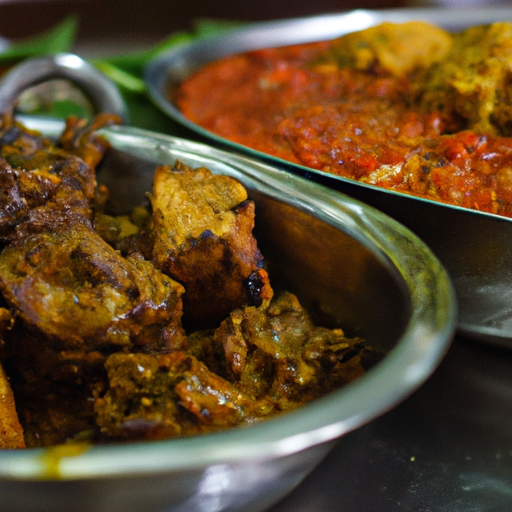Experience the vibrant flavors and culinary traditions of India as we take you on a journey to explore the fascinating contrast between North and South Indian cuisine. From the aromatic biryanis and succulent kebabs of the North to the fiery curries and tangy dosas of the South, each region boasts its own distinct culinary identity that reflects the diverse cultural heritage of the country. Join us as we unravel the intricacies of these two culinary worlds, delving into the spices, techniques, and ingredients that make them so unique. Prepare to tantalize your taste buds and expand your culinary horizons as we delve into the culinary diversity of India.

North Indian Cuisine
Overview
North Indian cuisine is known for its rich and flavorful dishes that are enjoyed by people all over the world. It is characterized by its abundant use of dairy products, such as yogurt, cream, and ghee, as well as a variety of spices. The cuisine of North India is heavily influenced by Mughlai and Punjabi cooking styles, resulting in dishes that are aromatic, creamy, and indulgent.
Ingredients
In North Indian cuisine, a wide range of ingredients are used to create unique and delectable dishes. Some of the staple ingredients include wheat, rice, lentils, vegetables, and dairy products. Spices like cumin, coriander, turmeric, and garam masala are essential for adding depth and flavor to the dishes. North Indian cuisine also makes ample use of nuts, such as almonds and cashews, to enhance the richness of the food.
Flavors and Techniques
The flavors in North Indian cuisine are rich and diverse, with a balance of sweet, spicy, and tangy notes. The technique of tempering spices in hot oil or ghee, known as “tadka,” is commonly used to enhance the flavor and aroma of the dishes. Another popular technique is slow cooking, which allows the flavors to meld together and create a harmonious taste.
Popular North Indian Dishes
Some of the most beloved dishes of North Indian cuisine include butter chicken, biryani, palak paneer, tandoori chicken, and chole bhature. Butter chicken, also known as murgh makhani, is a creamy and flavorful chicken dish that is cooked in a tomato-based gravy. Biryani is a fragrant rice dish cooked with meat and aromatic spices, while palak paneer is a creamy spinach curry with cubes of paneer (Indian cottage cheese). Tandoori chicken is marinated in yogurt and spices, then cooked in a tandoor (clay oven), resulting in juicy and flavorful meat. Chole bhature is a popular street food dish consisting of spicy chickpea curry served with deep-fried bread.
South Indian Cuisine
Overview
South Indian cuisine is known for its distinct flavors, vegetarian specialties, and the prominent use of rice and coconut in its dishes. The cuisine of South India is heavily influenced by the coastal regions, resulting in dishes that are light, tangy, and aromatic. South Indian cuisine also boasts a wide variety of fermented foods, which contribute to its unique taste and texture.
Ingredients
The key ingredients in South Indian cuisine include rice, lentils, coconut, and an abundance of local fruits and vegetables. Coconuts are used in various forms, such as grated, coconut milk, or coconut oil, and play a major role in enhancing the flavors of the dishes. Lentils, known as dal, are a staple in South Indian cuisine and are used to make delicious curries and soups. Tamarind is another essential ingredient, known for its sour and tangy flavor.
Flavors and Techniques
South Indian cuisine offers a wide array of flavors, ranging from spicy to tangy and from sweet to savory. The distinct taste of South Indian food comes from the generous use of spices like mustard seeds, curry leaves, asafoetida, and red chili powder. The technique of tempering spices, known as “tadka” in North India, is also commonly used in South Indian cooking to infuse the flavors into the dishes. Fermentation is a crucial technique used in South Indian cuisine, which gives rise to popular fermented dishes like idli and dosa.
Popular South Indian Dishes
Some of the famous dishes of South Indian cuisine include dosa, idli, sambar, rasam, and coconut chutney. Dosa is a thin and crispy pancake made from fermented rice and lentil batter, commonly served with coconut chutney and sambar, a lentil-based vegetable stew. Idli, on the other hand, is a steamed rice cake made from fermented batter and is often served with chutney and sambar. Rasam is a tangy and spicy soup made with tamarind, tomatoes, and various spices. Coconut chutney is a creamy and flavorful accompaniment made from grated coconut, green chilies, and spices.

Regional Influences
North Indian Regional Influences
North Indian cuisine is not a monolithic entity but rather a diverse collection of regional cuisines, each with its own distinct flavors and influences. The cuisine of Punjab, for instance, is known for its robust and earthy flavors, with dishes like sarson ka saag (mustard greens curry) and makki di roti (cornmeal flatbread) being popular staples. The cuisine of Rajasthan, on the other hand, is characterized by its rich and spicy flavors, where dishes like dal baati churma (lentils and wheat balls) and gatte ki sabzi (gram flour dumplings in a spicy curry) delight the taste buds.
South Indian Regional Influences
Similarly, South Indian cuisine is also diverse and influenced by various regional factors. The cuisine of Karnataka, for example, is known for its use of coconut and jaggery, resulting in dishes that are slightly sweeter compared to other South Indian cuisines. The cuisine of Tamil Nadu, on the other hand, features a wide variety of vegetarian dishes and is known for its use of aromatic spices like fenugreek, mustard seeds, and curry leaves. Kerala cuisine, being a coastal region, boasts a rich tradition of seafood dishes and utilizes coconut in abundance.
Spices and Seasonings
Common Spices Used in North Indian Cuisine
North Indian cuisine is renowned for its extensive use of spices, which form the backbone of its rich and flavorful dishes. Some of the commonly used spices in North Indian cuisine include cumin, coriander, turmeric, cinnamon, cardamom, cloves, and garam masala. These spices add warmth, depth, and complexity to the dishes, while also imparting their unique flavors.
Common Spices Used in South Indian Cuisine
South Indian cuisine also incorporates a variety of spices to create its distinctive flavors. Mustard seeds, curry leaves, asafoetida, red chili powder, fenugreek seeds, and black pepper are some of the commonly used spices in South Indian cooking. These spices add a punch of flavor and give a unique taste to the dishes.
Different Methods of Seasoning
Both North and South Indian cuisines employ various methods of seasoning to enhance the flavors of the dishes. In North Indian cuisine, tempering or “tadka” is a common technique where spices are added to hot oil or ghee, releasing their flavors and aromas. In South Indian cuisine, a similar technique called “tadka” or “tarka” is used, where spices are tempered in hot oil or ghee and added to the dish, infusing it with the flavors of the spices.

Rice and Bread
Rice in North Indian Cuisine
Rice holds a significant place in North Indian cuisine and is a staple in many dishes. Basmati rice, with its long grains and aroma, is particularly favored and used in various biryanis and pulao dishes. Rice is also used to make dishes like jeera rice (cumin-flavored rice) and kheer (rice pudding), which are enjoyed as standalone meals or desserts.
Bread in North Indian Cuisine
Bread plays a crucial role in North Indian cuisine, with a wide variety of breads being popularly consumed. Naan, a soft and leavened bread, is a favorite accompaniment to curries and kebabs. Roti, also known as chapati, is a whole wheat bread that is commonly eaten with dal and vegetables. Other bread varieties such as paratha, kulcha, and puri are also enjoyed in North Indian cuisine.
Rice in South Indian Cuisine
In South Indian cuisine, rice takes center stage and is an integral part of the daily meals. South Indians consume rice in various forms, such as steamed rice, rice-based dishes like bisi bele bath (spicy rice and lentil dish), and fermented rice dishes like idli and dosa. Rice is also ground to make rice flour, which is used to make snacks, desserts, and breads.
Bread in South Indian Cuisine
While bread is not as prominent in South Indian cuisine compared to North Indian cuisine, there are still some popular bread varieties. Appam, a fermented rice and coconut pancake, is commonly eaten with stews and curries. Malabar paratha, also known as Kerala paratha, is a flaky and layered flatbread that is enjoyed with curries and gravies.
Vegetarian and Non-vegetarian
Vegetarian Dishes in North Indian Cuisine
North Indian cuisine offers a wide range of vegetarian dishes that are filled with flavors and textures. Popular vegetarian dishes include paneer tikka, vegetable biryani, aloo gobhi (potato and cauliflower curry), and dal makhani (buttery lentil curry). These dishes showcase the versatility of vegetables, legumes, and dairy products in creating satisfying and delicious meals.
Non-vegetarian Dishes in North Indian Cuisine
Non-vegetarian dishes are an integral part of North Indian cuisine, with meat and poultry being prepared in a variety of flavorful ways. Butter chicken, chicken tikka masala, kebabs, and biryanis with goat or chicken are some beloved non-vegetarian dishes. These dishes are known for their rich gravies, tender meat, and aromatic spices.
Vegetarian Dishes in South Indian Cuisine
South Indian cuisine is primarily known for its vegetarian specialties, with a wide variety of meatless dishes available. Idli, dosa, sambar, and rasam are some of the iconic vegetarian dishes that are enjoyed with coconut chutney and vegetable side dishes. South Indian cuisine showcases the flavorful combination of lentils, rice, vegetables, and spices in its vegetarian offerings.
Non-vegetarian Dishes in South Indian Cuisine
While vegetarian dishes dominate the culinary landscape of South India, there are still some non-vegetarian options available. Chettinad chicken curry, fish curry, prawn masala, and mutton biryani are some examples of non-vegetarian dishes that reflect the coastal influences and rich flavors of South Indian cuisine.
Street Food
Famous Street Food in North India
North India is famous for its vibrant street food culture, with a plethora of delicious and affordable options available. Some popular street food dishes include chaat, golgappe (pani puri), samosa, aloo tikki, and chole bhature. These dishes are known for their bold flavors, spicy chutneys, and crunchy textures, making them a favorite among locals and tourists alike.
Famous Street Food in South India
South India also boasts a vibrant street food scene, offering a wide variety of delectable snacks and meals. Some famous street food dishes include dosa, vada, idli, masala puri, and bisi bele bath. These dishes are loved for their simplicity, flavors, and ability to satisfy hunger on the go. The hygiene and taste of South Indian street food make it a must-try experience for food enthusiasts.
Regional Sweet Delights
Traditional Sweets in North India
North Indian cuisine is known for its rich and indulgent desserts that cater to a variety of taste preferences. Some traditional sweets include gulab jamun, jalebi, kheer, rasgulla, and gajar ka halwa. These sweets are made using ingredients like milk, sugar, nuts, and clarified butter, resulting in mouthwatering creations that are enjoyed on special occasions and festivals.
Traditional Sweets in South India
South Indian cuisine offers a wide array of delectable sweets that are loved for their unique flavors and textures. Some traditional sweets include mysore pak, coconut barfi, payasam, modak, and ladoo. These sweets showcase the use of ingredients like coconut, jaggery, rice flour, and lentils, resulting in desserts that are both sweet and savory.
Influence on Indian Cuisine
North Indian Cuisine’s Influence on Indian Cuisine
North Indian cuisine has had a significant impact on Indian cuisine as a whole. The flavors, techniques, and dishes of North India have permeated other regional cuisines, resulting in the fusion and evolution of Indian food. The rich and creamy gravies, the aromatic biryanis, and the kebabs of North Indian origin have become popular across the country, showcasing the influence and popularity of this cuisine.
South Indian Cuisine’s Influence on Indian Cuisine
South Indian cuisine has also made its mark on Indian cuisine and has gained popularity nationwide. Dishes like dosa, idli, and sambar have become beloved breakfast items across India, while coconut-based curries and seafood preparations are enjoyed across different regions. The use of tangy tamarind flavors, coconut, and the unique fermented dishes of South India have contributed to the diverse culinary tapestry of the country.
The Culinary Diversity of India
North vs. South: A Gastronomic Journey
The culinary diversity of India is a treasure trove of flavors and traditions, with the cuisine of North and South India offering distinct gastronomic experiences. The rich and indulgent flavors of North Indian cuisine, with its creamy gravies and aromatic spices, provide a culinary journey that satisfies the senses. On the other hand, the vibrant and tangy flavors of South Indian cuisine, with its fermented dishes and coconut-based curries, offer a unique and refreshing gastronomic adventure.
Exploring the Flavors of India
India’s culinary heritage is a testament to its diverse cultural influences and traditions. From the robust flavors of North Indian cuisine to the light and tangy flavors of South Indian cuisine, every region offers a unique and delightful experience. Exploring the flavors of India means embarking on a journey of spices, aromatic herbs, and techniques passed down through generations. Whether you savor the rich gravies of the North or indulge in the crisp dosas of the South, the culinary diversity of India is sure to leave you craving for more.

